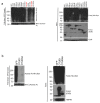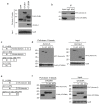OTUD6A Is an Aurora Kinase A-Specific Deubiquitinase
- PMID: 33669244
- PMCID: PMC7919836
- DOI: 10.3390/ijms22041936
OTUD6A Is an Aurora Kinase A-Specific Deubiquitinase
Abstract
Aurora kinases are serine/threonine kinases required for cell proliferation and are overexpressed in many human cancers. Targeting Aurora kinases has been a therapeutic strategy in cancer treatment. Here, we attempted to identify a deubiquitinase (DUB) that regulates Aurora kinase A (Aurora-A) protein stability and/or kinase activity as a potential cancer therapeutic target. Through pull-down assays with the human DUB library, we identified OTUD6A as an Aurora-A-specific DUB. OTUD6A interacts with Aurora-A through OTU and kinase domains, respectively, and deubiquitinates Aurora-A. Notably, OTUD6A promotes the protein half-life of Aurora-A and activates Aurora-A by increasing phosphorylation at threonine 288 of Aurora-A. From qPCR screening, we identified and validated that the cancer gene CKS2 encoding Cyclin-dependent kinases regulatory subunit 2 is the most upregulated cell cycle regulator when OTUD6A is overexpressed. The results suggest that OTUD6A may serve as a therapeutic target in human cancers.
Keywords: Aurora kinase A; OTUD6A; cancer; deubiquitinase.
Conflict of interest statement
The authors declare no conflict of interest.
Figures





References
-
- Giet R., Prigent C. Aurora/Ipl1p-related kinases, a new oncogenic family of mitotic serine-threonine kinases. Pt 21J. Cell Sci. 1999;112:3591–3601. - PubMed
-
- Gritsko T.M., Coppola D., Paciga J.E., Yang L., Sun M., Shelley S.A., Fiorica J.V., Nicosia S.V., Cheng J.Q. Activation and overexpression of centrosome kinase BTAK/Aurora-A in human ovarian cancer. Clin. Cancer Res. 2003;9:1420–1426. - PubMed
MeSH terms
Substances
Grants and funding
LinkOut - more resources
Full Text Sources
Other Literature Sources
Molecular Biology Databases
Research Materials
Miscellaneous

